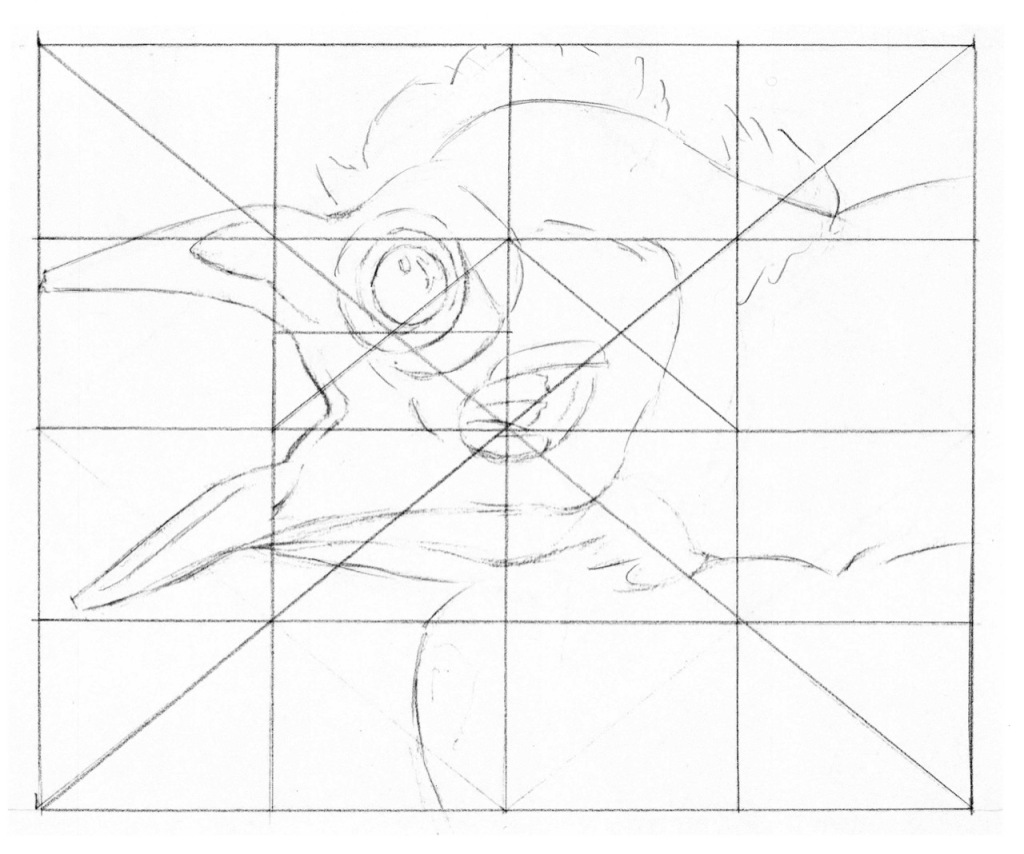A while back, I posted a step-by-step pen and ink drawing of a Northern Mockingbird. The post may be viewed here. Occasionally, I paint birds in watercolour, as well. I’ve done a few recently and I thought I’d show you a bit of my process.
Several years ago, I was teaching an en plein air watercolour class on the Toronto waterfront. It was during the month of June and the trees were alive with busy local nesting birds. At one point, I reached for my binoculars to check out the source of some particularly harsh squalling. It was a fledgling, a young bird that had only very recently left the nest. It was one of the ugliest creatures I’d ever seen and I didn’t know what species it was until a parent dropped by with a beakfull of nourishment for the hungry youngster. I won’t reveal the species right away. Let’s talk about my process.
I worked from my own photo back in the studio. I print both a colour and a black and white version. The black and white version helps me see and understand the values. I grid the colour version and then draw a rectangle of the exact same proportion on my paper. I used a small block of Arches, Hot Press, 140lb., watercolour paper. Using the grid, I draw the bird with a very light touch of a soft 2B pencil. The pencil lines are quite faint and hard to see but easy to clean up with an eraser. For the sake of this post, I strengthened the drawing so that it would be clearer.

So far, the first step is identical to what I did with my pen and ink drawing of the Northern Mockingbird. This is a watercolour, however. Step Two means it’s time to paint. I mix Burnt Sienna with Cobalt Blue in order to create a cool/neutral grey. In Step Two I painted a narrow range of values to show the darker areas of the bird and also to suggest texture.

Local colour is introduced with Step Three. Our fledging is a fairly colourful creature. I ‘glaze’ thin washes of colour where needed.

Step Four is really a series of steps as I continue to develop colour and value. I step back a lot and take short breaks. The stepbacks and breaks are just as important as touching the brush to the paper. Eventually, the painting is finished.

By the way, I don’t use opaque white paint. I reserve the white of the paper. It’s challenging, especially when there are white areas on the bird. Can you guess the species? It’s a young Red-winged Blackbird.
I’ll show you one more bird painting while I have your attention. It’s another common urban bird and this time I’ll just show two steps. Here is the ‘monochromatic’ stage of this study of a House Sparrow. Again, I’ve used a few values at this point.


The House Sparrow is not a colourful bird, at all. I stuck with the combination of Burnt Sienna and Cobalt Blue for the entire painting. Also, I gradually darken these paintings as the ‘light to dark’ process is very forgiving. These paintings are quite small, only 4 by 5 inches or so. The image on your screen is probably larger than the actual watercolour study. I hope you find this approach useful for working from your own photographs. It’s just one way to do it as, of course, there are likely as many ways to paint birds as there are artists. If you’d like to view more of my bird studies, click here.
Tags: House Sparrow, Red-winged Blackbird, watercolor, watercolour
13/02/2021 at 5:47 pm |
Lovely work! I love Study of House Sparrow, what a sweet rendition.
13/02/2021 at 5:58 pm |
Nice work! Sad looking little fellow. Cheers, Judith
J. Davidson-PalmerJDP Fine Artwww.judithdavidsonpalmer.com
27/02/2021 at 10:33 am |
Thanks!
13/02/2021 at 7:06 pm |
Amazing work!
27/02/2021 at 10:33 am |
Thanks very much!
14/02/2021 at 10:15 am |
Excellent tips! I’ve been painting cards lately as I’ve run out of space for large paintings! My birds are not nearly as detailed and correct as yours, but am happy to say they sell very well – have sold about 300 altogether. The first card here is entitled “The Bird Watcher”. Keep well, regards Sandra
________________________________
27/02/2021 at 10:34 am |
Well done with the cards, Sandra!
15/02/2021 at 10:14 am |
It’s always a pleasure to scroll through your paintings and sketches The birds are so beautifully rendered with all that cross hatching, your patience must be endless. Please keep them coming!
27/02/2021 at 10:35 am |
I’ll try to devote some time to it. Glad you like them.
18/02/2021 at 8:56 am |
Thanks for sharing your sensational work on the various birds.
27/02/2021 at 10:35 am |
You’re welcome!
05/03/2021 at 12:14 pm |
Hi Barry,
I have been attempting birds myself too! Your blog is inspirational!
Have been visited by redpolls this winter as well as the regular winter chaps! I miss your classes however these blogs have been very helpful as I am attempting to draw, paint, pen and ink, the little visitors to our gardens and feeders! I continue to follow your methodology. Reading your notes I almost hear your voice!
Hopefully one day I can again participate in your classes.
Regards
Anne Burghardt
06/03/2021 at 10:54 am |
Hi Anne,
I’m glad that you’re trying your hand at birds. I think I saw an eBird post of yours. Tufted Titmouse along the Grand? Cheers, Barry